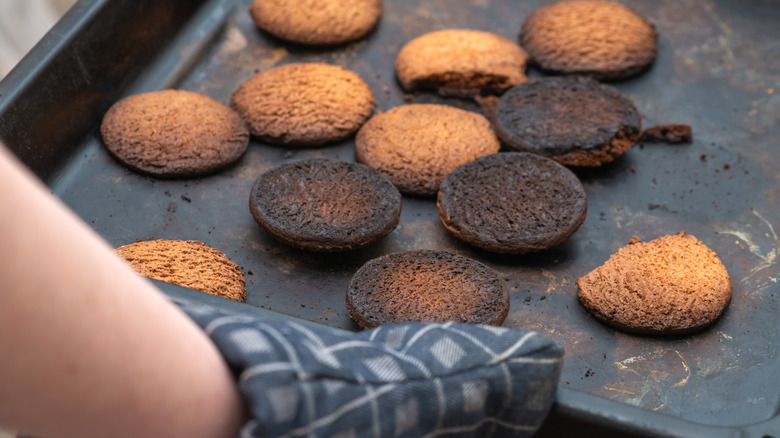The Simple Baking Tip To Prevent A Burnt Batch Of Cookies
If you're baking a new cookie recipe for the first time, it can be hard to determine when you should take your baked goods out of the oven. While no one wants cookies that are still raw on the inside, ones that are hard and overcooked can be just as disappointing. So how do you avoid a burnt batch of cookies?
You might assume that the best way to go about it is to constantly check in on them by opening the oven door, but unfortunately, this tends to have the opposite effect. It interferes with the temperature of the oven, preventing the cookies from baking properly, and potentially leaving you with cookies that are burnt at the bottom but still underbaked on the top.
A much more effective method is to simply do a trial run on a single cookie. Add just one scoop of dough to the tray, then bake it according to your best judgment. Based on the outcome of this test cookie, you can pretty easily figure out how long you should be baking the rest of the batch. And even if it ends up burning, at least it will be only one and not the entire tray.
How a test cookie can be helpful
Though too high of an oven temperature or a prolonged baking time are the most common culprits of burnt cookies, they aren't the only ones. Burnt cookies can also be caused by the wrong proportions of ingredients. Too much butter and not enough flour will cause the cookies to spread more which will in turn lead to burnt edges. An excessive amount of sugar, on the other hand, promotes more caramelization, resulting in burning on the bottoms.
If there's an issue with the ratios of the ingredients in the dough, the level of brownness on the edges or bottom of a test cookie will be able to tell you that. If the brownness appears relatively even in all areas, you'll know that you just have to adjust the temperature or baking time rather than modify the whole recipe. Once you identify the potential problem areas, it's easier to prevent your cookies from burning.
Maximizing the accuracy of a test cookie
Doing a trial run on one cookie is usually a reliable indicator of how the whole batch will cook, however, there are certain factors that can affect this, mainly the starting temperature of the dough. In other words, if you bake your test cookie right after mixing the dough, but chill or freeze the rest, you won't be able to accurately determine when they might burn. Therefore, for best results, make sure the dough for your test cookie and the rest of the batch are in the same state before baking.
The tray you use also matters. Since you're only baking one cookie, you might be tempted to use a different, perhaps smaller pan, but you'll actually want to use the same one you plan on using for your entire batch. This is because the rate of browning can be influenced by the type of pan you use. A rimmed cookie sheet, for example, interferes with the distribution of heat, while a dark baking tray tends to cause the bottoms to crisp up. If the pan had something to do with your cookies burning, you wouldn't be able to tell unless you used the same one both times. A test cookie won't do you any good if you change too many variables.


